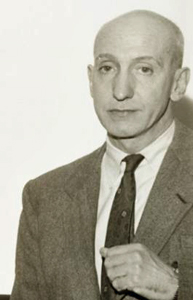
Paul Jackson Pollock was an American painter. A major figure in the abstract expressionist movement, Pollock was widely noticed for his "drip technique" of pouring or splashing liquid household paint onto a horizontal surface, enabling him to view and paint his canvases from all angles. It was called all-over painting and action painting, since he covered the entire canvas and used the force of his whole body to paint, often in a frenetic dancing style. This extreme form of abstraction divided the critics: some praised the immediacy of the creation, while others derided the random effects. In 2016, Pollock's painting titled Number 17A was reported to have fetched US$200 million in a private purchase.

James David Brooks was an American Abstract Expressionist, muralist, abstract painter, art teacher, and winner of the Logan Medal of the Arts.

Conrad Marca-Relli was an American artist who belonged to the early generation of New York School Abstract Expressionist artists whose artistic innovation by the 1950s had been recognized across the Atlantic, including Paris. New York School Abstract Expressionism, represented by Jackson Pollock, Willem de Kooning, Franz Kline, Robert Motherwell, Marca-Relli and others became a leading art movement of the postwar era.

Robert Engman was an American sculptor with works in the permanent collection of the Hirshhorn Museum, MOMA, the Whitney Museum of American Art, numerous college museums, and private collections.
Lawrence "Larry" Zox was an American painter and printmaker who is classified as an Abstract expressionist, Color Field painter and a Lyrical Abstractionist, although he did not readily use those categories for his work.
Friedel Dzubas was a German-born American abstract painter.

Joseph Glasco was an American painter, draftsman and sculptor. He is most known for his early figurative drawings and paintings and in later years for deconstructing the figure to develop his non-objective paintings building on abstraction of the 1950s.

Herbert Ferber was an American Abstract Expressionist, sculptor and painter, and a "driving force of the New York School."

Irving Kriesberg was an American painter, sculptor, educator, author, and filmmaker, whose work combined elements of Abstract Expressionism with representational human, animal, and humanoid forms. Because Kriesberg blended formalist elements with figurative forms he is often considered to be a Figurative Expressionist.
Charles Seliger was an American abstract expressionist painter. He was born in Manhattan June 3, 1926, and he died on 1 October 2009, in Westchester County, New York. Seliger was one of the original generation of abstract expressionist painters connected with the New York School.

Grace Hartigan was an American Abstract Expressionist painter and a significant member of the vibrant New York School of the 1950s and 1960s. Her circle of friends, who frequently inspired one another in their artistic endeavors, included Jackson Pollock, Larry Rivers, Helen Frankenthaler, Willem and Elaine de Kooning and Frank O'Hara. Her paintings are held by numerous major institutions, including the Museum of Modern Art in New York City. As director of the Maryland Institute College of Art's Hoffberger School of Painting, she influenced numerous young artists.
Lester Johnson was an American artist and educator. Johnson was a member of the Second Generation of the New York School during the late 1950s. The subject of much of his work is the human figure. His style is considered by critics and art historians to be in the figurative expressionist mode.
Michael Loew was an American Abstract Expressionist artist who was born in New York City.
Jack Albert Youngerman was an American artist known for his constructions and paintings.
George Earl Ortman was an American painter, printmaker, constructionist and sculptor. His work has been referred to as Neo-Dada, pop art, minimalism and hard-edge painting. His constructions, built with a variety of materials and objects, deal with the exploration off visual language derived from geometry—geometry as symbol and sign.
Rochelle Feinstein is a contemporary American visual artist that makes abstract paintings, prints, video, sculpture, and installations that explore language and contemporary culture. She was appointed professor in painting and printmaking at the Yale School of Art in 1994, where she also served as director of graduate studies, until becoming professor emerita in 2017.

George McNeil was an American abstract expressionist painter.
John Millard Ferren was an American artist and educator. He was active from 1920 until 1970 in San Francisco, Paris and New York City.
Galerie Huit was an art collective and gallery established by American artists in Paris in 1950. During the mid-twentieth century American artists traveled and lived in Paris to study and make art. Many of the male American artists were able to finance excursions to France because of the Servicemen's Readjustment Act of 1944. The city provided access to modern art as well as African art. Led by Haywood Rivers, American artists in Paris at that time united to create a cooperative gallery space to show their work.
Jonah Kinigstein is an American artist known for his Expressionist paintings.









